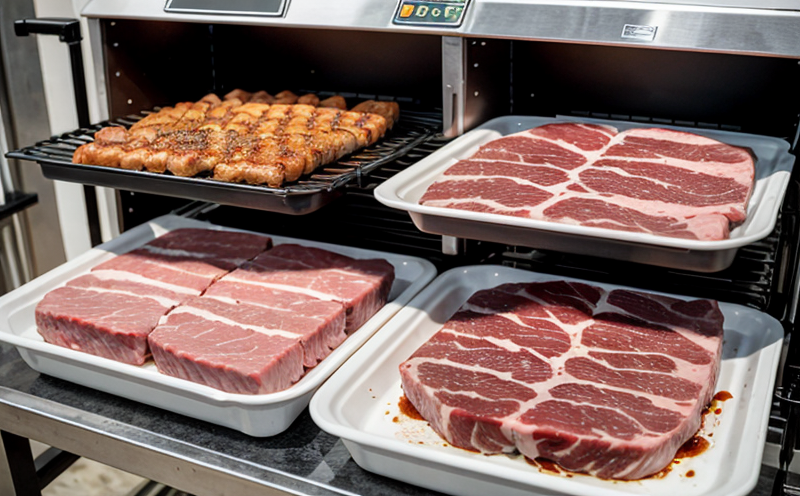ISO 6868 Copper Residue Testing in Meat Products
The ISO 6868 standard provides a comprehensive method for determining copper residue levels in meat products. This testing procedure is critical for ensuring the safety and quality of food and feed products, particularly those intended for human consumption.
Copper is an essential trace element that supports various physiological functions such as connective tissue formation, blood vessel integrity, and iron metabolism. However, excessive copper can lead to toxicity in humans, causing gastrointestinal disorders, liver damage, and even death at high concentrations. Therefore, it is crucial to monitor the levels of copper in meat products.
The ISO 6868 method uses an acid digestion process followed by atomic absorption spectrometry (AAS) or inductively coupled plasma optical emission spectroscopy (ICP-OES). This approach ensures accurate and reliable measurement of copper residues. The digestion step involves dissolving the sample with nitric acid, and subsequent analysis identifies the trace amount of copper present.
The testing process begins with proper specimen preparation. Meat samples are cut into small pieces, homogenized, and dried before being weighed out to an accurate mass. Acid digestion is then carried out under controlled conditions to ensure complete breakdown without interfering with the analytical procedure. Once digested, the solution undergoes filtration to remove any undigested particles.
The next step involves diluting the filtered digestate according to specified ratios to bring it within the linear range of the analytical instrument being used. The sample is then analyzed using either AAS or ICP-OES, depending on the laboratory's equipment and preference for precision and throughput.
| Step | Description |
|---|---|
| Cut the meat into small pieces. | This ensures even digestion and accurate measurement. |
| Homogenize the sample. | Reduces variability in the test results due to non-uniformity of the sample. |
| Dry the homogenized sample. | Makes it easier to weigh and reduces the volume of the sample for digestion. |
| Weigh out an accurate mass of the dried sample. | Ensures consistent results in every test run. |
The analytical process adheres strictly to ISO 6868 guidelines, which specify the use of specific wavelengths for AAS or spectral lines for ICP-OES. The detection limit is set at a very low level (typically below 0.1 ppm), ensuring that even trace amounts of copper can be detected.
The results are reported as weight per unit volume (ppm) and should not exceed the maximum limits specified by relevant food safety regulations such as those outlined in Codex Alimentarius or EU directives. Compliance with these standards is vital for maintaining consumer confidence and ensuring legal adherence.
Benefits
- Promotes compliance with international food safety regulations.
- Ensures product quality by eliminating excessive copper residues.
- Reduces the risk of health issues associated with copper toxicity in consumers.
- Safeguards brand reputation and customer trust.
Eurolab Advantages
As a leading provider of food testing services, Eurolab offers several advantages when it comes to ISO 6868 copper residue testing in meat products:
- State-of-the-art laboratories equipped with the latest analytical instruments.
- Experienced and certified analysts who specialize in this type of analysis.
- A commitment to continuous improvement through regular training and certification updates.
- Robust quality management systems that ensure consistent high-quality results.
Use Cases and Application Examples
| Use Case | Description |
|---|---|
| Supplier Audits and Evaluations | Conducting tests on raw materials to ensure they meet quality standards before being processed. |
| Process Monitoring | Regular checks during production processes to maintain consistent copper residue levels within acceptable limits. |
| Finished Product Testing | Final inspections of packaged products before release to market, ensuring compliance with regulatory requirements. |
- A food manufacturing company undergoing an audit by a third-party certification body requires ISO 6868 copper residue testing on its raw materials and finished products.
- An importer of meat products into the EU must ensure that all imported shipments comply with European Union standards for copper content in foodstuffs.





